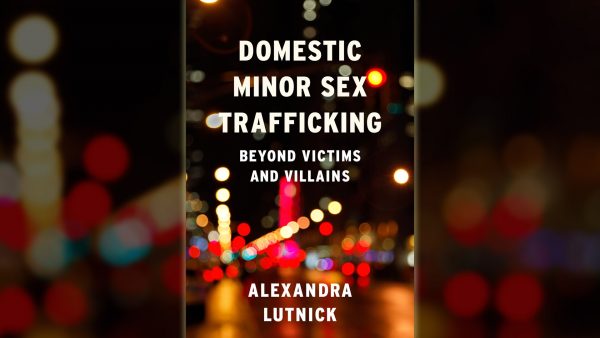 When I got arrested recently, my copy of Domestic Minor Sex Trafficking: Beyond Victims and Villains by Alexandra Lutnick came along with me to jail. It’d be fair to blame me, as well as the boys in blue, but I think it’s unlikely that this is the last time this publication will see the inside of an evidence vault or be fondled by the fingers of a police sergeant.
When I got arrested recently, my copy of Domestic Minor Sex Trafficking: Beyond Victims and Villains by Alexandra Lutnick came along with me to jail. It’d be fair to blame me, as well as the boys in blue, but I think it’s unlikely that this is the last time this publication will see the inside of an evidence vault or be fondled by the fingers of a police sergeant.
After bail, tearing open my blue possessions bag, I couldn’t help thinking that this book was meant to be in lockup with me. It wasn’t published solely for those with degrees in social service. The text exudes empathy for those left behind in the system. Domestic Minor Sex Trafficking reminds me of the bourbon-infused evenings of my teenage years. I remember feeling desolate and distressed in hotel rooms, dreaming of a world with enough beds and snug blankets.
The text expertly covers the disparity of my vision of the world of sex work and the broader statistical realities of it. This book is exceptionally sourced, as it needs to be in order to defend itself from the inevitable barrage of critique that will come in response to its claims about our failed social structure.
Lutnick isn’t another hapless academic reminding society that there’s an unseen conveyor belt of children being trafficked around the country. This is a view the mainstream media seems far too fond of, one that fails to realize our failures as a culture when it comes to the root causes of youth sex trade work. Instead, she argues that isolating minor sex workers in the margins of society allows us to flee our inherent responsibility to them. The book vigorously motions against a system which criminalizes minors who’ve entered into sex work willingly to escape abusive households. Lutnick contends that the vision our society promotes of young white cis women controlled by external forces is deceptive. Youth in the sex trade are far more diverse in origin, gender identity, and age than popularized media representations of them would lead us to believe.
These minors should be viewed with respect, as conscious proponents of their own motives. Lutnick notes that those left behind in systems of oppression are far more likely to be involved in sex work, as an escape from their abusers as well as systemic violence. As a young femme, there was nowhere for me to go besides the streets. There was money there, opportunity for advancement and excitement. Domestic Minor Sex Trafficking reflects my realities and those of my contemporaries with a clear vision of the true nature of minor sex work.

My primary contention with Lutnick’s work is the term “minor.” The target population of her research is variable. Infants to working-age teenagers all fall under the overarching term “minor.” My assumption is that the minors referred to in the book are age 14 to 17, often too young to legally consent to sex, but old enough to be charged with the crime of prostitution. In defense of her use of the term, Lutnick points out that different social service agencies disagree about the definition of the next most commonly used demographic term, “youth.” Although no longer a minor, according to many agencies, I’m still a youth, and I have been been for the past five years of my engagement with sex work.
Lutnick’s use of polls and communiques originating from social service outreach programs also comes with some flaws. Youth currently accessing services are poorly monitored for clinical follow-up. Privacy requirements and legal restrictions around minors leave some studies mentioned in Domestic Minor Sex Trafficking vague, lacking specific context. In my experience, youths who accessed one service were far more likely to access other services, causing duplication in statistics. Entry requirements, specifically those barring youth who’ve been incarcerated, make many of these services entirely useless to young people impacted by the stresses that lead to sex work. Lutnick proposes a fissure between the perceived needs of these youths by social workers and the wishes of minor sex workers themselves.
Recall those ubiquitous change jars at Walmart with pictures of young white girls and words like: “trafficking”, “save”, and “starving” printed on them. The media terrifies us with the fear of losing our children to trafficking. This monster under the bed can seem far more immediate and real to media consumers than the more complicated dangers youth in the sex trade actually face. The story of Peter Truong and Boy 1 is more palatable to us than the more prosaic reality of broken homes and a failed system of criminalization.
Through her statistical analysis, Lutnick proposes that very little evidence exists to substantiate the supposed epidemic of trafficked prepubescent children. But the public’s vision of minor trafficking involves inflated anti-trafficking NGO estimates of thousands of very young missing children. There are certainly cases of “true trafficking”—youth targeted by predators—included in these estimates. But, as Lutnick spells out, the legislation currently intended to protect these youths is more often a hindrance to those attempting to develop a life outside of sex work. Caught up in stings meant to target trafficked minors, hundreds each year are trapped in the webs of law enforcement and their lives are changed forever because of it. My conviction as a youth arrested in an anti-trafficking operation has impacted my life far more than the best efforts of court-appointed social workers.
Lutnick makes it clear that the study of prostitution is mired in inconsistent research which fails to stand up to academic scrutiny. Domestic Minor Sex Trafficking analyzes many commonly quoted articles and studies touting conflated trafficking figures and finds them lacking. The text exposes many statistics cited in purported good faith by politicians to protect children and women as flagrant fabrications. The qualitative data I’ve collected through my life experience in sex work isn’t represented by the statistics I hear in social justice circles. But Lutnick aptly illuminates my experiences. Along the way, she exposes the misguided efforts of legislators and social workers and the way they derail the lives of marginalized youth.
I kept thumbing through Domestic Minor Sex Trafficking, page by page, enraptured. I questioned how truly inclusive and comprehensive this work was. Reading the text, I tried and failed to find a divisive sentence, some indicator of dubious intent from a non-sex worker author. I kept waiting for Lutnick to slip up and leave someone out. I wanted justification for my inherent distrust of the social service sector, forged by years of disregard. I couldn’t find any.
Instead, I gained trust in the author as I became acquainted with her compassion and reason. Succinct and simply written, Domestic Minor Sex Trafficking is an effective shock to the academic thinking that marginalizes sex workers and neglects their autonomy. Hopefully, this book will trigger critical thinking on the narratives of children lost between the cracks of our society. Without timid prose, Lutnick has penned a work representative of the experiences of those of us who’ve spent time under a lamppost at a young age.
Domestic Minor Sex Trafficking offers long overdue insight into those who audaciously ventured empty-handed into criminal territory in their youth. Seeking a life far from the abuse they fled in their homes of origin, these youth stand out in stark contrast to the bogeymen junkies and pimps which populate our public imagination. Inevitably, there will be a capstone to this era of criminalization, a Sinclarian novel that awakens the populace to the pain children like me suffered, legislation that puts our needs first. Through the efforts of social workers and sex workers alike, we can rectify the trauma brought on by those we call guardians of these children.

Thank you.
Lunch & Learn with Dr. Alix Lutnick, Author of Domestic Minor Sex Trafficking: Beyond Victims and Villains
http://sextraffickingalaska.com/lunch-learn-with-dr-alix-lutnick-author-of-domestic-minor-sex-trafficking-beyond-victims-and-villains/
Good grief the woman is awesome and she’s one of the few fully loaded academics who is working to change things in our favor. Picking apart the use of the word ‘minor’ is petty. She’s using the legal terminology she needs to use in the arena she is working in. Thank goodness for her work!